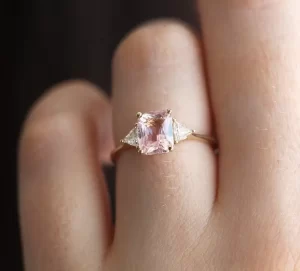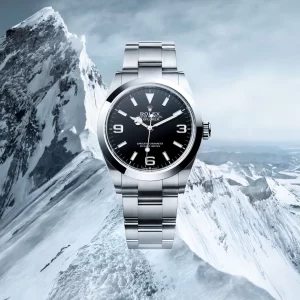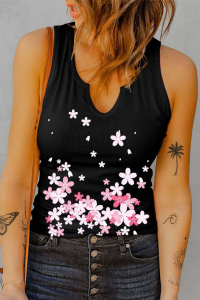All you need to know to clear your doubts about Moissanite
 Moissanite is an extremely rare artificial gemstone. Natural microscopic particles were discovered for the first time in Arizona, in a crater created by a meteorite fallen on earth, by a French scientist named Henri Moissan. It was then created in the laboratory and cut by the American company Charles & Colvard. It has properties similar to diamonds such as colour and hardness; on the other hand, it has a fire, a shine and a lustre much larger than that of a diamond. It is a central stone ideal for engagement rings. They are cut in many classic shapes like the round and the oval, and others more original like the dry Moissanite, marquise, pear and heart. This moissanite guide is produced to make you discover this spectacular stone.
Moissanite is an extremely rare artificial gemstone. Natural microscopic particles were discovered for the first time in Arizona, in a crater created by a meteorite fallen on earth, by a French scientist named Henri Moissan. It was then created in the laboratory and cut by the American company Charles & Colvard. It has properties similar to diamonds such as colour and hardness; on the other hand, it has a fire, a shine and a lustre much larger than that of a diamond. It is a central stone ideal for engagement rings. They are cut in many classic shapes like the round and the oval, and others more original like the dry Moissanite, marquise, pear and heart. This moissanite guide is produced to make you discover this spectacular stone.
Properties of Moissanite
The visual characteristics of Moissanite make it a unique category of stones. It has a hardness of 9.5 on the Mohs scale, which makes it the second hardest stone after the diamond, so it is excellent, resistant to bumps and scratches. Its refractive index is very high (2.65 to 2.69) and therefore more elevated than that of a diamond, which gives Moissanite an exceptional sparkle. The dispersion of light through the stone is also significant; the light thus crosses the gem and separates into colours of the rainbow called fire. Moissanite withstands high temperatures of heat, so it will not undergo any change in colour or composition during a repair.
Moissanite manufacturing
The Moissanite is easily made in the laboratory. However, the gem-quality used in jewellery and jewellery required several years of research to develop the manufacturing process, which allows having a hard, shiny stone and a white colour similar to diamonds. Moissanite is a rare artificial stone since it takes two to three months to produce a single gem. Discover the manufacturing process of Moissanite to understand better the reason for its rarity and why it is not considered as synthetic stone.
How to recognize Moissanite?
The difference between a diamond and Moissanite is not visible to the naked eye. Moissanite looks so much like a diamond that tests performed with essential gemological equipment cannot detect the differences between Moissanite solitaire rings and a diamond. However, with a discerning eye and a magnifying glass x 10, you can catch the only optical element that differentiates them, called double refraction.
Double refraction means that when a ray of light enters the gemstone, it is slowed down, bent and divided into two rays of light, it then creates a double facet. The best way to observe this double facet is to hold the precious stone to be able to see the Colette (the angle of the aspect of the crown). This optical effect is manifested by a secondary blurred image particularly visible at this location. Repeat this test again by varying the angle of inclination. If the doubling reappears, you can confirm your suspicions.
The reason is its strong birefringence between 0.030 and 0.045 and a dispersion index of 0.104 much higher than that of the known diamond at 0.044. Indeed, under the magnifying glass, the junctions of the facets of a diamond are sharp and sharp.
Difference between Moissanite and diamond
The craze for moissanites has been growing in recent years. An impressive number of couples is carried by the purchase of an engagement ring with a central stone in Moissanite. It offers more options for choosing more complex models and larger stones.
Unlike many stones that darken over time, Moissanite retains its lustre and whiteness through the generations. It is 10% brighter than diamond, and it reflects light in hypnotic bursts of fire. It is also one of the most challenging elements known on earth, which makes it extremely resistant. It is available in a variety of sizes and shapes.
Moissanite is, therefore, an excellent alternative to diamond, but despite the striking resemblance between Moissanite and diamond, several elements differentiate it. So that you can make an informed decision, take the time to discover this particular stone and choose between diamond and Moissanite according to your priorities.
Price of a moissanite
Moissanite is a beautiful stone. Its price represents a very decisive element. Moissanite gems cost a fraction of what an actual diamond costs if you compare the same size and quality. The saving on the purchase of large cut stone is enormous; for example, Moissanite of 1 carat can cost 650 euros depending on its quality. In comparison, a GIA certified diamond of 1 carat can cost around 5000 euros and more depending on the quality. The more original forms of diamonds are even more expensive since the loss during cutting is greater.
Types of Moissanite
The Moissanite known today on the market are manufactured by the company Charles & Colvard in the United States. The quality of the Moissanite it produces is recognized worldwide since it was the first to create gem-quality Moissanite in X. They developed three types of Moissanite: Forever Classic, Forever One, and Forever Brilliant. We will detail here the qualities of each to help you choose the type that suits you best. From Alexander Sparks, you can find the best ones.
Classic moissa1nite
It is the first Moissanite created by Charles & Colvard, it offers a stone of good hardness, but with shades of green, yellow and grey colours. It corresponds to the colour diamond JK.
Brilliant Moissanite
Thanks to the improvement of the crystal growth process, they were able to obtain a better range of Moissanite, brilliant and almost colourless. It corresponds to a GHI coloured diamond. It is an interesting option since it represents the good understood cost quality for this stone.
Moissanite Options
Years of research and high technology have enabled the companies to offer a high-quality stone on the market. Breathtaking shine and perfect white colour. It is similar to the colourless diamond DEF.
Supernova moissanite
In past decades, Charles & Colvard were the only manufacturers of Moissanite since they held their patent for the invention. But since 2016, the patent has expired, and other competitors have appeared such as Moissanite International. It is an Australian company that offers fantastic moissanite stones called moissanite supernova. This Moissanite is at the same level of quality as Forever One moissanite and therefore provides a colourless range equivalent to DEF diamond.
For better value for money, divinely has chosen supernova moissanite for its jewellery. It will be accompanied by its certificate of authenticity and guarantee, produced by the manufacturing laboratory.






